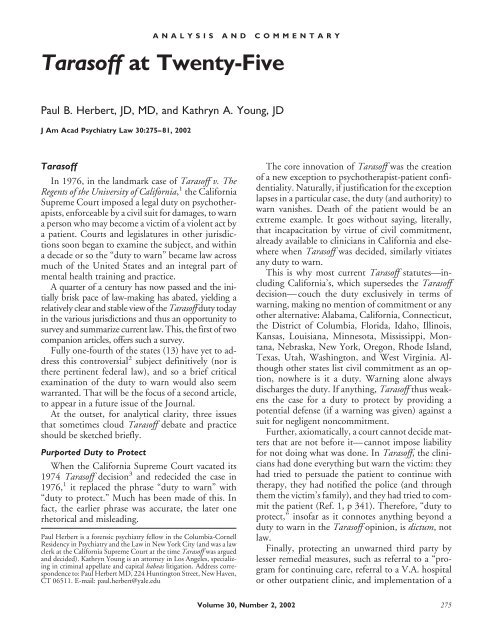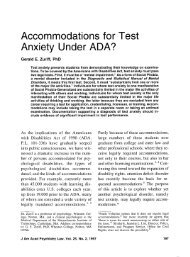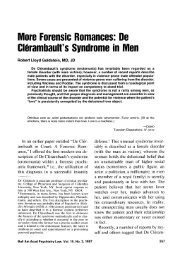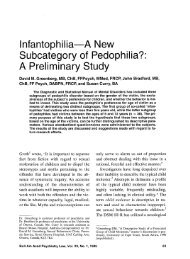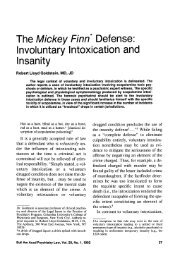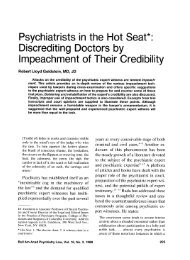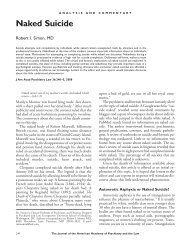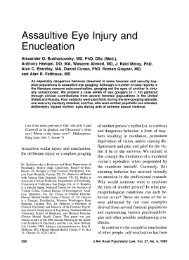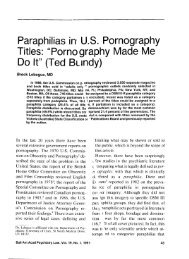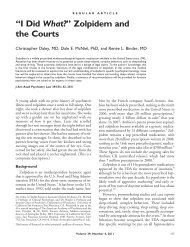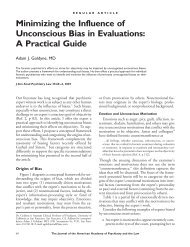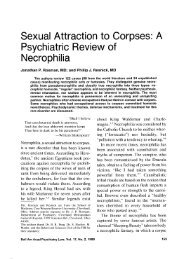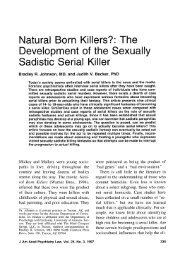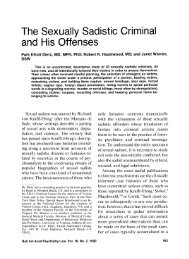Tarasoff at Twenty-Five - Journal of the American Academy of ...
Tarasoff at Twenty-Five - Journal of the American Academy of ...
Tarasoff at Twenty-Five - Journal of the American Academy of ...
Create successful ePaper yourself
Turn your PDF publications into a flip-book with our unique Google optimized e-Paper software.
<strong>Taras<strong>of</strong>f</strong> <strong>at</strong> <strong>Twenty</strong>-<strong>Five</strong><br />
Paul B. Herbert, JD, MD, and K<strong>at</strong>hryn A. Young, JD<br />
J Am Acad Psychi<strong>at</strong>ry Law 30:275–81, 2002<br />
<strong>Taras<strong>of</strong>f</strong><br />
In 1976, in <strong>the</strong> landmark case <strong>of</strong> <strong>Taras<strong>of</strong>f</strong> v. The<br />
Regents <strong>of</strong> <strong>the</strong> University <strong>of</strong> California, 1 <strong>the</strong> California<br />
Supreme Court imposed a legal duty on psycho<strong>the</strong>rapists,<br />
enforceable by a civil suit for damages, to warn<br />
a person who may become a victim <strong>of</strong> a violent act by<br />
a p<strong>at</strong>ient. Courts and legisl<strong>at</strong>ures in o<strong>the</strong>r jurisdictions<br />
soon began to examine <strong>the</strong> subject, and within<br />
a decade or so <strong>the</strong> “duty to warn” became law across<br />
much <strong>of</strong> <strong>the</strong> United St<strong>at</strong>es and an integral part <strong>of</strong><br />
mental health training and practice.<br />
A quarter <strong>of</strong> a century has now passed and <strong>the</strong> initially<br />
brisk pace <strong>of</strong> law-making has ab<strong>at</strong>ed, yielding a<br />
rel<strong>at</strong>ively clear and stable view <strong>of</strong> <strong>the</strong> <strong>Taras<strong>of</strong>f</strong> duty today<br />
in <strong>the</strong> various jurisdictions and thus an opportunity to<br />
survey and summarize current law. This, <strong>the</strong> first <strong>of</strong> two<br />
companion articles, <strong>of</strong>fers such a survey.<br />
Fully one-fourth <strong>of</strong> <strong>the</strong> st<strong>at</strong>es (13) have yet to address<br />
this controversial 2 subject definitively (nor is<br />
<strong>the</strong>re pertinent federal law), and so a brief critical<br />
examin<strong>at</strong>ion <strong>of</strong> <strong>the</strong> duty to warn would also seem<br />
warranted. Th<strong>at</strong> will be <strong>the</strong> focus <strong>of</strong> a second article,<br />
to appear in a future issue <strong>of</strong> <strong>the</strong> <strong>Journal</strong>.<br />
At <strong>the</strong> outset, for analytical clarity, three issues<br />
th<strong>at</strong> sometimes cloud <strong>Taras<strong>of</strong>f</strong> deb<strong>at</strong>e and practice<br />
should be sketched briefly.<br />
Purported Duty to Protect<br />
When <strong>the</strong> California Supreme Court vac<strong>at</strong>ed its<br />
1974 <strong>Taras<strong>of</strong>f</strong> decision 3 and redecided <strong>the</strong> case in<br />
1976, 1 it replaced <strong>the</strong> phrase “duty to warn” with<br />
“duty to protect.” Much has been made <strong>of</strong> this. In<br />
fact, <strong>the</strong> earlier phrase was accur<strong>at</strong>e, <strong>the</strong> l<strong>at</strong>er one<br />
rhetorical and misleading.<br />
Paul Herbert is a forensic psychi<strong>at</strong>ry fellow in <strong>the</strong> Columbia-Cornell<br />
Residency in Psychi<strong>at</strong>ry and <strong>the</strong> Law in New York City (and was a law<br />
clerk <strong>at</strong> <strong>the</strong> California Supreme Court <strong>at</strong> <strong>the</strong> time <strong>Taras<strong>of</strong>f</strong> was argued<br />
and decided). K<strong>at</strong>hryn Young is an <strong>at</strong>torney in Los Angeles, specializing<br />
in criminal appell<strong>at</strong>e and capital habeas litig<strong>at</strong>ion. Address correspondence<br />
to: Paul Herbert MD, 224 Huntington Street, New Haven,<br />
CT 06511. E-mail: paul.herbert@yale.edu<br />
ANALYSIS AND COMMENTARY<br />
Volume 30, Number 2, 2002<br />
The core innov<strong>at</strong>ion <strong>of</strong> <strong>Taras<strong>of</strong>f</strong> was <strong>the</strong> cre<strong>at</strong>ion<br />
<strong>of</strong> a new exception to psycho<strong>the</strong>rapist-p<strong>at</strong>ient confidentiality.<br />
N<strong>at</strong>urally, if justific<strong>at</strong>ion for <strong>the</strong> exception<br />
lapses in a particular case, <strong>the</strong> duty (and authority) to<br />
warn vanishes. De<strong>at</strong>h <strong>of</strong> <strong>the</strong> p<strong>at</strong>ient would be an<br />
extreme example. It goes without saying, literally,<br />
th<strong>at</strong> incapacit<strong>at</strong>ion by virtue <strong>of</strong> civil commitment,<br />
already available to clinicians in California and elsewhere<br />
when <strong>Taras<strong>of</strong>f</strong> was decided, similarly viti<strong>at</strong>es<br />
any duty to warn.<br />
This is why most current <strong>Taras<strong>of</strong>f</strong> st<strong>at</strong>utes—including<br />
California’s, which supersedes <strong>the</strong> <strong>Taras<strong>of</strong>f</strong><br />
decision—couch <strong>the</strong> duty exclusively in terms <strong>of</strong><br />
warning, making no mention <strong>of</strong> commitment or any<br />
o<strong>the</strong>r altern<strong>at</strong>ive: Alabama, California, Connecticut,<br />
<strong>the</strong> District <strong>of</strong> Columbia, Florida, Idaho, Illinois,<br />
Kansas, Louisiana, Minnesota, Mississippi, Montana,<br />
Nebraska, New York, Oregon, Rhode Island,<br />
Texas, Utah, Washington, and West Virginia. Although<br />
o<strong>the</strong>r st<strong>at</strong>es list civil commitment as an option,<br />
nowhere is it a duty. Warning alone always<br />
discharges <strong>the</strong> duty. If anything, <strong>Taras<strong>of</strong>f</strong> thus weakens<br />
<strong>the</strong> case for a duty to protect by providing a<br />
potential defense (if a warning was given) against a<br />
suit for negligent noncommitment.<br />
Fur<strong>the</strong>r, axiom<strong>at</strong>ically, a court cannot decide m<strong>at</strong>ters<br />
th<strong>at</strong> are not before it—cannot impose liability<br />
for not doing wh<strong>at</strong> was done. In <strong>Taras<strong>of</strong>f</strong>, <strong>the</strong> clinicians<br />
had done everything but warn <strong>the</strong> victim: <strong>the</strong>y<br />
had tried to persuade <strong>the</strong> p<strong>at</strong>ient to continue with<br />
<strong>the</strong>rapy, <strong>the</strong>y had notified <strong>the</strong> police (and through<br />
<strong>the</strong>m <strong>the</strong> victim’s family), and <strong>the</strong>y had tried to commit<br />
<strong>the</strong> p<strong>at</strong>ient (Ref. 1, p 341). Therefore, “duty to<br />
protect,” ins<strong>of</strong>ar as it connotes anything beyond a<br />
duty to warn in <strong>the</strong> <strong>Taras<strong>of</strong>f</strong> opinion, is dictum, not<br />
law.<br />
Finally, protecting an unwarned third party by<br />
lesser remedial measures, such as referral to a “program<br />
for continuing care, referral to a V.A. hospital<br />
or o<strong>the</strong>r outp<strong>at</strong>ient clinic, and implement<strong>at</strong>ion <strong>of</strong> a<br />
275
program to monitor [<strong>the</strong> p<strong>at</strong>ient’s] medic<strong>at</strong>ion,” 4<br />
will, after a tragedy, be unlikely to impress a jury th<strong>at</strong><br />
knows more could have been done and hears expert<br />
testimony th<strong>at</strong> more should have been done. 5<br />
<strong>Taras<strong>of</strong>f</strong> and its st<strong>at</strong>utory and case law progeny<br />
<strong>the</strong>refore, as a practical m<strong>at</strong>ter, distill down to a duty<br />
to warn, in essentially two situ<strong>at</strong>ions. One is where<br />
<strong>the</strong> <strong>the</strong>rapist believes <strong>the</strong> p<strong>at</strong>ient is not a danger to<br />
himself (or herself) or o<strong>the</strong>rs or is not mentally ill—<br />
hence, not committable—but he (or she) has made a<br />
thre<strong>at</strong> to harm ano<strong>the</strong>r (or, in some jurisdictions, a<br />
suicide thre<strong>at</strong>). This would occur ei<strong>the</strong>r in discharging<br />
an inp<strong>at</strong>ient or in electing not to hospitalize an<br />
outp<strong>at</strong>ient—th<strong>at</strong> is, in <strong>the</strong> case <strong>of</strong> a decision not to<br />
contain <strong>the</strong> p<strong>at</strong>ient. The second situ<strong>at</strong>ion arises from<br />
inability to contain <strong>the</strong> p<strong>at</strong>ient, such as when an outp<strong>at</strong>ient<br />
phones in a thre<strong>at</strong> or an inp<strong>at</strong>ient elopes.<br />
Privilege Versus Confidentiality<br />
The psycho<strong>the</strong>rapist-p<strong>at</strong>ient privilege, some version<br />
<strong>of</strong> which all jurisdictions now have, 6 is distinct<br />
from psycho<strong>the</strong>rapist-p<strong>at</strong>ient confidentiality. 7<br />
Privilege, a modern concept, 6 is <strong>the</strong> right <strong>of</strong> <strong>the</strong><br />
p<strong>at</strong>ient not to have a psycho<strong>the</strong>rapist disclose in judicial<br />
proceedings “any confidential communic<strong>at</strong>ion<br />
between p<strong>at</strong>ient and psycho<strong>the</strong>rapist.” 8<br />
Confidentiality is <strong>the</strong> ancient oblig<strong>at</strong>ion <strong>of</strong> <strong>the</strong><br />
psycho<strong>the</strong>rapist not to divulge in any setting <strong>the</strong><br />
identity <strong>of</strong> <strong>the</strong> p<strong>at</strong>ient as a p<strong>at</strong>ient or any inform<strong>at</strong>ion<br />
about <strong>the</strong> p<strong>at</strong>ient known to <strong>the</strong> <strong>the</strong>rapist by virtue <strong>of</strong><br />
<strong>the</strong> <strong>the</strong>rapeutic rel<strong>at</strong>ionship. As Hippocr<strong>at</strong>es enjoined,<br />
“Wh<strong>at</strong>soever things I see or hear concerning<br />
<strong>the</strong> life <strong>of</strong> men, in my <strong>at</strong>tendance on <strong>the</strong> sick or even<br />
apart <strong>the</strong>refrom, which ought not to be noised<br />
abroad, I will keep silence <strong>the</strong>reon, counting such<br />
things to be as sacred secrets.” 9<br />
One <strong>of</strong> <strong>the</strong> exceptions to privilege recognized in<br />
some jurisdictions is <strong>the</strong> “dangerous p<strong>at</strong>ient exception”<br />
6 designed to untie <strong>the</strong> hands <strong>of</strong> courts (e.g., in<br />
a commitment hearing) with respect to future violence.<br />
Some courts have melded <strong>the</strong> dangerous p<strong>at</strong>ient<br />
exception to privilege with <strong>the</strong> <strong>Taras<strong>of</strong>f</strong> exception<br />
to confidentiality (also conceived to prevent<br />
future violence), to make psycho<strong>the</strong>rapists into<br />
oblig<strong>at</strong>ory witnesses for <strong>the</strong> prosecution against <strong>the</strong>ir<br />
p<strong>at</strong>ients with respect to purely past acts, reasoning<br />
th<strong>at</strong> confidentiality is permanently lost once a <strong>Taras<strong>of</strong>f</strong><br />
duty arises, even if no warning is given. 10 Some<br />
comment<strong>at</strong>ors have denounced this “criminaliz<strong>at</strong>ion”<br />
<strong>of</strong> <strong>Taras<strong>of</strong>f</strong>, 11 and one court has agreed. 7<br />
<strong>Taras<strong>of</strong>f</strong> <strong>at</strong> <strong>Twenty</strong>-<strong>Five</strong><br />
Pr<strong>of</strong>essional Ethics<br />
Ethics codes are unlikely to be determin<strong>at</strong>ive. After<br />
all, no disciplinary sanctions could ensue from<br />
following <strong>the</strong> law, and no clinician (one hopes)<br />
would subordin<strong>at</strong>e his or her moral compass to a<br />
generic code <strong>of</strong> ethics on a m<strong>at</strong>ter, literally, <strong>of</strong> life and<br />
de<strong>at</strong>h. The psychi<strong>at</strong>ry code <strong>of</strong> ethics comes down<br />
squarely on <strong>the</strong> fence: “Psychi<strong>at</strong>rists <strong>at</strong> times may<br />
find it necessary, in order to protect <strong>the</strong> p<strong>at</strong>ient or <strong>the</strong><br />
community from imminent danger, to reveal confidential<br />
inform<strong>at</strong>ion disclosed by <strong>the</strong> p<strong>at</strong>ient.” 12<br />
The Duty To Warn in <strong>the</strong> United St<strong>at</strong>es<br />
In <strong>Taras<strong>of</strong>f</strong>, <strong>the</strong> court declared th<strong>at</strong> “once a <strong>the</strong>rapist<br />
does in fact determine, or under applicable pr<strong>of</strong>essional<br />
standards reasonably should have determined,<br />
th<strong>at</strong> a p<strong>at</strong>ient poses a serious danger <strong>of</strong><br />
violence to o<strong>the</strong>rs, he bears a duty to exercise reasonable<br />
care to protect <strong>the</strong> foreseeable victim <strong>of</strong> th<strong>at</strong><br />
danger” (Ref. 1, p 345). Because it was a decision by<br />
a st<strong>at</strong>e appell<strong>at</strong>e court, it was law only in th<strong>at</strong> st<strong>at</strong>e,<br />
California. Soon, however, <strong>the</strong> notion <strong>of</strong> a duty to<br />
warn crept across most <strong>of</strong> <strong>the</strong> n<strong>at</strong>ion, by court decisions<br />
or legisl<strong>at</strong>ive enactment. In <strong>the</strong> process, important<br />
vari<strong>at</strong>ions have emerged.<br />
Common Law Versus St<strong>at</strong>ute<br />
New law can be made or existing law changed by<br />
appell<strong>at</strong>e courts (common law, or precedent) or by<br />
legisl<strong>at</strong>ures (st<strong>at</strong>utory law). <strong>Taras<strong>of</strong>f</strong> was a judicial<br />
innov<strong>at</strong>ion in (or extension <strong>of</strong>) common law. Many<br />
courts have considered a duty to warn since <strong>Taras<strong>of</strong>f</strong><br />
was decided—and invariably cite <strong>Taras<strong>of</strong>f</strong> in doing<br />
so—but most <strong>of</strong> <strong>the</strong> duty to warn law as it exists<br />
today is st<strong>at</strong>utory.<br />
California is illustr<strong>at</strong>ive. <strong>Taras<strong>of</strong>f</strong> itself no longer<br />
defines <strong>the</strong> duty to warn in th<strong>at</strong> st<strong>at</strong>e. In 1985, <strong>the</strong><br />
st<strong>at</strong>e legisl<strong>at</strong>ure superseded <strong>the</strong> case by enacting a<br />
st<strong>at</strong>ute th<strong>at</strong> currently provides:<br />
. . . no cause <strong>of</strong> action shall arise against . . . any . . . psycho<strong>the</strong>rapist<br />
in failing to warn <strong>of</strong> and protect from a p<strong>at</strong>ient’s thre<strong>at</strong>ened<br />
violent behavior or failing to predict and warn <strong>of</strong> and protect<br />
from a p<strong>at</strong>ient’s violent behavior except where <strong>the</strong> p<strong>at</strong>ient has<br />
communic<strong>at</strong>ed to <strong>the</strong> psycho<strong>the</strong>rapist a serious thre<strong>at</strong> <strong>of</strong> physical<br />
violence against a reasonably identified victim. ...If<strong>the</strong>re<br />
is a duty to warn and protect under <strong>the</strong> limited circumstances<br />
specified above, <strong>the</strong> duty shall be discharged by <strong>the</strong> psycho<strong>the</strong>rapist<br />
making reasonable efforts to communic<strong>at</strong>e <strong>the</strong> thre<strong>at</strong> to<br />
<strong>the</strong> victim ...andtoalawenforcement agency. 13<br />
This st<strong>at</strong>ute appears to curtail <strong>Taras<strong>of</strong>f</strong> slightly in<br />
requiring an explicit thre<strong>at</strong> from <strong>the</strong> p<strong>at</strong>ient. At <strong>the</strong><br />
276 The <strong>Journal</strong> <strong>of</strong> <strong>the</strong> <strong>American</strong> <strong>Academy</strong> <strong>of</strong> Psychi<strong>at</strong>ry and <strong>the</strong> Law
same time, it potentially expands <strong>Taras<strong>of</strong>f</strong> slightly, in<br />
th<strong>at</strong> it expressly requires notific<strong>at</strong>ion <strong>of</strong> both law enforcement<br />
and <strong>the</strong> victim (not just <strong>the</strong> victim, as<br />
<strong>Taras<strong>of</strong>f</strong> implied). Fur<strong>the</strong>r, it makes plain, notwithstanding<br />
<strong>the</strong> incant<strong>at</strong>ion “and protect,” th<strong>at</strong> <strong>the</strong> only<br />
duty is to warn: “. . . <strong>the</strong> duty shall be discharged by<br />
. . . reasonable efforts to communic<strong>at</strong>e <strong>the</strong> thre<strong>at</strong> to<br />
<strong>the</strong> victim ...andtoalawenforcement agency.” 13<br />
As in California, <strong>the</strong> basic duty-to-warn law currently<br />
in force in most <strong>of</strong> <strong>the</strong> jurisdictions th<strong>at</strong> have<br />
such a law is st<strong>at</strong>utory. This, however, does not end<br />
or neg<strong>at</strong>e <strong>the</strong> role <strong>of</strong> courts in sculpting such law.<br />
Again, California is illustr<strong>at</strong>ive. The California<br />
Court <strong>of</strong> Appeal was called on to apply th<strong>at</strong> st<strong>at</strong>e’s<br />
duty-to-warn st<strong>at</strong>ute (just quoted) in Barry v.<br />
Turek. 14 A brain-injured p<strong>at</strong>ient on a locked psychi<strong>at</strong>ric<br />
ward habitually engaged in grabbing and fondling<br />
improprieties toward female nurses and had to<br />
be continuously redirected from such activities.<br />
However, as <strong>the</strong> court makes clear, he “never made<br />
verbal thre<strong>at</strong>s <strong>of</strong> violence within <strong>the</strong> hearing <strong>of</strong> [defendant,<br />
<strong>the</strong> ward’s chief psychi<strong>at</strong>rist]”(Ref. 14, p<br />
554). Under <strong>the</strong> st<strong>at</strong>ute, <strong>the</strong> absence <strong>of</strong> an explicit<br />
thre<strong>at</strong> should seemingly end <strong>the</strong> case, as <strong>the</strong> court<br />
itself acknowledged (Ref. 14, p 554).<br />
Eventually, a hospital employee was assaulted<br />
more seriously than those in <strong>the</strong> previous incidents,<br />
and she sued <strong>the</strong> p<strong>at</strong>ient’s psychi<strong>at</strong>rist for failure to<br />
warn. Despite <strong>the</strong> st<strong>at</strong>ute’s clear language requiring<br />
th<strong>at</strong> <strong>the</strong> p<strong>at</strong>ient communic<strong>at</strong>e to <strong>the</strong> psycho<strong>the</strong>rapist<br />
a serious thre<strong>at</strong> <strong>of</strong> physical violence, <strong>the</strong> court asked<br />
“whe<strong>the</strong>r [<strong>the</strong> plaintiff] has sufficiently shown th<strong>at</strong><br />
[<strong>the</strong> defendant] ought to have been aware th<strong>at</strong> [<strong>the</strong><br />
p<strong>at</strong>ient] presented a serious thre<strong>at</strong> <strong>of</strong> physical violence”<br />
(Ref. 14, p 555).<br />
The court concluded th<strong>at</strong> <strong>the</strong> assault was not<br />
reasonably foreseeable. The point, however, is th<strong>at</strong><br />
st<strong>at</strong>utes, no m<strong>at</strong>ter how clearly written, may be<br />
malleable in <strong>the</strong> hands <strong>of</strong> courts called on to interpret<br />
<strong>the</strong>m. Thus, although most duty-to-warn law<br />
now is st<strong>at</strong>utory, psycho<strong>the</strong>rapists can never rest<br />
fully assured th<strong>at</strong> a court decision will not abruptly<br />
alter <strong>the</strong>ir oblig<strong>at</strong>ions in this area, as occurred in<br />
<strong>Taras<strong>of</strong>f</strong> itself. 15<br />
Summary <strong>of</strong> <strong>the</strong> Law<br />
The 52 jurisdictions in <strong>the</strong> United St<strong>at</strong>es (<strong>the</strong> 50<br />
st<strong>at</strong>es and <strong>the</strong> District <strong>of</strong> Columbia, plus federal law<br />
governing tribal lands, Puerto Rico, Guam, <strong>the</strong> Vir-<br />
Herbert and Young<br />
Volume 30, Number 2, 2002<br />
gin Islands, and o<strong>the</strong>r territories) currently break<br />
down into four basic c<strong>at</strong>egories.<br />
About half <strong>of</strong> <strong>the</strong> st<strong>at</strong>es (27), following <strong>Taras<strong>of</strong>f</strong>,<br />
impose a mand<strong>at</strong>ory duty to warn, although <strong>the</strong> precise<br />
contours <strong>of</strong> <strong>the</strong> duty vary considerably. Ano<strong>the</strong>r<br />
10 jurisdictions (9 st<strong>at</strong>es plus <strong>the</strong> District <strong>of</strong> Columbia)<br />
accord psycho<strong>the</strong>rapists permission to warn<br />
(viz., an exception to psycho<strong>the</strong>rapist-p<strong>at</strong>ient confidentiality)<br />
without explicitly imposing a duty to<br />
warn. One st<strong>at</strong>e, Virginia, fl<strong>at</strong>ly rejects <strong>Taras<strong>of</strong>f</strong>, <strong>at</strong><br />
least in <strong>the</strong> outp<strong>at</strong>ient context. The remaining 14<br />
jurisdictions (13 st<strong>at</strong>es, plus federal law) have no definitive<br />
law on <strong>the</strong> issue.<br />
The Duty Jurisdictions<br />
<strong>Twenty</strong>-seven st<strong>at</strong>es impose a duty to breach psycho<strong>the</strong>rapist-p<strong>at</strong>ient<br />
confidentiality and warn <strong>of</strong> potential<br />
violence against a third party: Arizona, 16 Cal-<br />
ifornia, 13 Colorado, 17 Delaware, 18<br />
Idaho, 19<br />
Indiana, 20 Kentucky, 21 Louisiana, 22 Maryland, 23<br />
Massachusetts, 24 Michigan, 25 Minnesota, 26 Mississippi,<br />
27 Missouri, 28 Montana, 29 Nebraska, 30 New<br />
Hampshire, 31 New Jersey, 32 Ohio, 33 Oklahoma, 34<br />
Pennsylvania, 35 South Carolina, 36 Tennessee, 37<br />
Utah, 38 Vermont, 39 Washington, 40 and Wisconsin. 41<br />
The contours (and clarity) <strong>of</strong> this duty differ<br />
widely from jurisdiction to jurisdiction—a function,<br />
in part, <strong>of</strong> variability in <strong>the</strong> quality <strong>of</strong> legisl<strong>at</strong>ive<br />
craftsmanship and, in part, presumably, owing to<br />
quite dispar<strong>at</strong>e levels <strong>of</strong> basic enthusiasm for <strong>the</strong> duty-to-warn<br />
principle. The general formul<strong>at</strong>ion is th<strong>at</strong><br />
a mental health worker is oblig<strong>at</strong>ed promptly to notify<br />
ei<strong>the</strong>r <strong>the</strong> potential victim or <strong>the</strong> police when a<br />
p<strong>at</strong>ient makes an explicit thre<strong>at</strong> <strong>of</strong> serious physical<br />
harm against a readily identifiable third party (or<br />
optionally, in some st<strong>at</strong>es, to hospitalize <strong>the</strong> p<strong>at</strong>ient).<br />
An important vari<strong>at</strong>ion among <strong>the</strong> duty st<strong>at</strong>es is<br />
whe<strong>the</strong>r <strong>the</strong> duty is nondiscretionary—th<strong>at</strong> is, an<br />
essentially ministerial function <strong>of</strong> simply transmitting<br />
a thre<strong>at</strong> <strong>of</strong> violence versus subject to a predic<strong>at</strong>e<br />
judgment by <strong>the</strong> psycho<strong>the</strong>rapist as to <strong>the</strong> p<strong>at</strong>ient’s<br />
factual ability to fulfill <strong>the</strong> thre<strong>at</strong>. Twelve st<strong>at</strong>es—<br />
California, Colorado, Indiana, Kentucky, Minnesota,<br />
Mississippi, Montana, Nebraska, New Hampshire,<br />
South Carolina, Utah, and Washington—<br />
couch <strong>the</strong> duty as rel<strong>at</strong>ively nondiscretionary.<br />
Montana’s st<strong>at</strong>ute, for example, provides:<br />
A mental health pr<strong>of</strong>essional has a duty to warn <strong>of</strong> or take<br />
reasonable precautions to provide protection from violent behavior<br />
only if <strong>the</strong> p<strong>at</strong>ient has communic<strong>at</strong>ed to <strong>the</strong> mental<br />
277
health pr<strong>of</strong>essional an actual thre<strong>at</strong> <strong>of</strong> physical violence by specific<br />
means against a clearly identified or reasonably identifiable<br />
victim. 29<br />
Ano<strong>the</strong>r 14 duty st<strong>at</strong>es—Arizona, Delaware,<br />
Idaho, Louisiana, Maryland, Massachusetts, Michigan,<br />
Missouri, New Jersey, Ohio, Oklahoma, Pennsylvania,<br />
Tennessee, and Vermont—explicitly incorpor<strong>at</strong>e<br />
<strong>the</strong> <strong>the</strong>rapist’s judgment into <strong>the</strong> duty<br />
equ<strong>at</strong>ion. Idaho’s st<strong>at</strong>ute is typical:<br />
A mental health pr<strong>of</strong>essional has a duty to warn a victim if a<br />
p<strong>at</strong>ient has communic<strong>at</strong>ed to <strong>the</strong> mental health pr<strong>of</strong>essional an<br />
explicit thre<strong>at</strong> <strong>of</strong> imminent serious physical harm or de<strong>at</strong>h to a<br />
clearly identified or identifiable victim or victims, and <strong>the</strong> p<strong>at</strong>ient<br />
has <strong>the</strong> apparent intent and ability to carry out such a<br />
thre<strong>at</strong>. 19<br />
The law <strong>of</strong> Wisconsin, <strong>the</strong> remaining duty st<strong>at</strong>e, is<br />
unclear on this, as it is on many o<strong>the</strong>r particulars.<br />
The Wisconsin Supreme Court, in a four-to-three<br />
vote, established <strong>Taras<strong>of</strong>f</strong> liability by dictum in a case<br />
not involving thre<strong>at</strong>s or any o<strong>the</strong>r evidence <strong>of</strong> violent<br />
intention. 41<br />
Many additional vari<strong>at</strong>ions exist among <strong>the</strong> duty<br />
st<strong>at</strong>es. Only a few can be highlighted.<br />
Indiana, Maryland, Massachusetts, and New Jersey<br />
all require a psycho<strong>the</strong>rapist not only to warn <strong>of</strong><br />
explicit thre<strong>at</strong>s by <strong>the</strong> p<strong>at</strong>ient but also to discern in<br />
his or her actions or <strong>the</strong> circumstances any thre<strong>at</strong> <strong>of</strong><br />
violence and to warn <strong>of</strong> this as well. The first three <strong>of</strong><br />
<strong>the</strong>se st<strong>at</strong>es specifically mand<strong>at</strong>e th<strong>at</strong> <strong>the</strong> psycho<strong>the</strong>rapist<br />
incorpor<strong>at</strong>e into this calculus <strong>the</strong> p<strong>at</strong>ient’s past<br />
acts <strong>of</strong> or propensity for violence.<br />
In Minnesota and Ohio, a <strong>the</strong>rapist is explicitly<br />
oblig<strong>at</strong>ed to warn not only <strong>of</strong> thre<strong>at</strong>s to which he or<br />
she is personally privy but also thre<strong>at</strong>s reported by a<br />
third party.<br />
Under <strong>the</strong> New Jersey law, thre<strong>at</strong>s <strong>of</strong> suicide also<br />
trigger a duty to warn. In Minnesota and Oklahoma,<br />
disclosure <strong>of</strong> suicide thre<strong>at</strong>s is discretionary.<br />
In Minnesota, not only are suicide thre<strong>at</strong>s subject<br />
to <strong>the</strong> <strong>Taras<strong>of</strong>f</strong> scheme, but provision is made for<br />
“[o]ptional disclosure . . . to third parties in a good<br />
faith effort to warn against or take precautions<br />
against a client’s violent behavior . . . for which a<br />
duty to warn does not arise.” 26 This potentially cre<strong>at</strong>es<br />
a large hole in <strong>the</strong> veil <strong>of</strong> confidentiality. Are<br />
rumin<strong>at</strong>ions th<strong>at</strong> are not quite thre<strong>at</strong>s no longer confidential?<br />
Wh<strong>at</strong> about thre<strong>at</strong>s th<strong>at</strong> are not necessarily<br />
violent, thre<strong>at</strong>s th<strong>at</strong> are vague as to <strong>the</strong> identity <strong>of</strong> any<br />
targets, thre<strong>at</strong>s <strong>of</strong> minor (not serious) violence, or<br />
thre<strong>at</strong>s against property?<br />
<strong>Taras<strong>of</strong>f</strong> <strong>at</strong> <strong>Twenty</strong>-<strong>Five</strong><br />
New Hampshire’s <strong>Taras<strong>of</strong>f</strong> st<strong>at</strong>ute mand<strong>at</strong>es disclosure<br />
<strong>of</strong> thre<strong>at</strong>s against real property (as well as<br />
those against persons). 31 Vermont’s supreme court<br />
decision establishing <strong>Taras<strong>of</strong>f</strong> liability also appears to<br />
extend to thre<strong>at</strong>s against real property. 39 However,<br />
<strong>the</strong> plurality opinion is most reasonably read as requiring<br />
a warning only when <strong>the</strong> thre<strong>at</strong> against property<br />
also jeopardizes life.<br />
The definition <strong>of</strong> covered mental health workers<br />
varies widely. In most st<strong>at</strong>es, it includes both psychi<strong>at</strong>rists<br />
and psychologists. Oklahoma imposes specific<br />
st<strong>at</strong>utory <strong>Taras<strong>of</strong>f</strong> liability only on psychologists,<br />
leaving <strong>the</strong> st<strong>at</strong>us <strong>of</strong> psychi<strong>at</strong>rists unclear. 34 Most<br />
st<strong>at</strong>es include licensed social workers and some o<strong>the</strong>r<br />
c<strong>at</strong>egories <strong>of</strong> licensed mental health workers, <strong>of</strong>ten<br />
including psychi<strong>at</strong>ric nurses and licensed marriage<br />
and family <strong>the</strong>rapists. Michigan includes music<br />
<strong>the</strong>rapists.<br />
Half <strong>of</strong> <strong>the</strong> duty st<strong>at</strong>es—Arizona, California, Colorado,<br />
Delaware, Idaho, Kentucky, Louisiana,<br />
Maryland, Michigan, Montana, Nebraska, Ohio,<br />
Utah, and Washington—require both prompt warning<br />
to <strong>the</strong> police and reasonable <strong>at</strong>tempts to warn <strong>the</strong><br />
potential victim. The o<strong>the</strong>r 13 purport to countenance<br />
less thorough warnings, but a prudent practitioner<br />
should abjure such an invit<strong>at</strong>ion into legal<br />
peril. Pennsylvania’s, South Carolina’s, Vermont’s,<br />
and Wisconsin’s <strong>Taras<strong>of</strong>f</strong> case law all provide th<strong>at</strong> <strong>the</strong><br />
potential victim must be warned and leave unaddressed<br />
<strong>the</strong> question <strong>of</strong> notific<strong>at</strong>ion <strong>of</strong> <strong>the</strong> police.<br />
Indiana, Massachusetts, Mississippi, Missouri, New<br />
Hampshire, New Jersey, and Oklahoma by st<strong>at</strong>ute all<br />
permit a warning to be made to <strong>the</strong> police or to<br />
<strong>the</strong> potential victim. Tennessee implies <strong>the</strong> same<br />
ei<strong>the</strong>r/or approach. Minnesota requires notific<strong>at</strong>ion<br />
<strong>of</strong> <strong>the</strong> police only if <strong>the</strong> potential victim cannot be<br />
reached. Clearly <strong>the</strong> safest (actually and legally) and<br />
simplest course is both to notify law enforcement and<br />
to document reasonable and prompt <strong>at</strong>tempts to<br />
warn <strong>the</strong> potential victim.<br />
The Permission Jurisdictions<br />
Nine st<strong>at</strong>es and <strong>the</strong> District <strong>of</strong> Columbia have split<br />
<strong>the</strong> baby by authorizing but not requiring a breach <strong>of</strong><br />
psycho<strong>the</strong>rapist-p<strong>at</strong>ient confidentiality, ostensibly<br />
leaving it to <strong>the</strong> discretion <strong>of</strong> <strong>the</strong> <strong>the</strong>rapist whe<strong>the</strong>r to<br />
warn a third party <strong>of</strong> a p<strong>at</strong>ient’s thre<strong>at</strong> <strong>of</strong> violence:<br />
Alaska, 42 Connecticut, 43 <strong>the</strong> District <strong>of</strong> Columbia, 44<br />
Florida, 45 Illinois, 46 New York, 47 Oregon, 48 Rhode<br />
Island, 49 Texas, 50 and West Virginia. 51<br />
278 The <strong>Journal</strong> <strong>of</strong> <strong>the</strong> <strong>American</strong> <strong>Academy</strong> <strong>of</strong> Psychi<strong>at</strong>ry and <strong>the</strong> Law
The important distinction among <strong>the</strong>se jurisdictions<br />
is th<strong>at</strong> in four <strong>of</strong> <strong>the</strong>m—Illinois, New York,<br />
Oregon, and Texas—<strong>the</strong> <strong>the</strong>rapist ostensibly has<br />
true discretion whe<strong>the</strong>r to disclose or not. The Illinois<br />
st<strong>at</strong>ute contains <strong>the</strong> unique phrase, “in <strong>the</strong> <strong>the</strong>rapist’s<br />
sole discretion”:<br />
. . . communic<strong>at</strong>ions may be disclosed. . .when, and to <strong>the</strong> extent,<br />
in <strong>the</strong> <strong>the</strong>rapist’s sole discretion, disclosure is necessary to<br />
warn or protect a specific individual against whom a recipient<br />
has made a specific thre<strong>at</strong> <strong>of</strong> violence .... 46<br />
How absolutely an Illinois court will construe “sole<br />
discretion” remains to be seen.<br />
New York’s st<strong>at</strong>ute provides for permissive disclosure<br />
“to an endangered individual and a law enforcement<br />
agency when a tre<strong>at</strong>ing psychi<strong>at</strong>rist or psychologist<br />
has determined th<strong>at</strong> a p<strong>at</strong>ient or client presents<br />
a serious and imminent danger to th<strong>at</strong> individual. . .”<br />
and <strong>the</strong>n emphasizes: “Nothing in this paragraph<br />
shall be construed to impose an oblig<strong>at</strong>ion upon a<br />
tre<strong>at</strong>ing psychi<strong>at</strong>rist or psychologist to release inform<strong>at</strong>ion<br />
pursuant to this paragraph.” 47 As in Illinois,<br />
this limiting language has not yet been judicially<br />
construed.<br />
Oregon’s st<strong>at</strong>ute, like New York’s, uses permissive<br />
language—“ a clear and immedi<strong>at</strong>e danger to o<strong>the</strong>rs<br />
or to society may be reported to <strong>the</strong> appropri<strong>at</strong>e authority”—and<br />
<strong>the</strong>n declares: “A decision not to disclose<br />
inform<strong>at</strong>ion under this subsection shall not<br />
subject <strong>the</strong> provider to any civil liability.” 48 Oregon’s<br />
highest court has examined this language and has<br />
unanimously accepted its plain meaning—“may”<br />
means may, not must. 7 One problem with Oregon’s<br />
st<strong>at</strong>ute is th<strong>at</strong> it applies only to “providers,” defined<br />
as public institutional mental health agencies and<br />
<strong>the</strong>ir staffs, leaving <strong>the</strong> law unclear for priv<strong>at</strong>e<br />
practitioners. 7<br />
The Texas st<strong>at</strong>ute unambiguously permits but<br />
does not require disclosure to law enforcement <strong>of</strong> a<br />
p<strong>at</strong>ient’s thre<strong>at</strong>s but does not require or permit disclosure<br />
to anyone else (including <strong>the</strong> victim). The<br />
Texas Supreme Court in Thapar v. Zezulka 52 emph<strong>at</strong>ically<br />
interpreted <strong>the</strong> st<strong>at</strong>ute to mean exactly<br />
wh<strong>at</strong> it says, fl<strong>at</strong>ly rejecting any <strong>Taras<strong>of</strong>f</strong> duty in<br />
Texas. Thus in Texas a <strong>the</strong>rapist has, by dint <strong>of</strong> <strong>the</strong><br />
law <strong>at</strong> least, no dilemma, morally or legally. If <strong>the</strong><br />
<strong>the</strong>rapist wants to warn, he or she may notify <strong>the</strong><br />
police (not <strong>the</strong> victim). If <strong>the</strong> <strong>the</strong>rapist wants to<br />
maintain <strong>the</strong> sanctity <strong>of</strong> confidentiality (or is unconvinced<br />
<strong>the</strong> thre<strong>at</strong> is serious), he or she may remain<br />
silent, incurring no legal exposure.<br />
Herbert and Young<br />
Volume 30, Number 2, 2002<br />
All <strong>of</strong> <strong>the</strong> o<strong>the</strong>r permission jurisdictions—Alaska,<br />
Connecticut, <strong>the</strong> District <strong>of</strong> Columbia, Florida,<br />
Rhode Island, and West Virginia—leave troublesomely<br />
open <strong>the</strong> possibility th<strong>at</strong> a court may engraft<br />
a duty onto permission (all <strong>the</strong> more likely, because<br />
<strong>the</strong> st<strong>at</strong>utory grant <strong>of</strong> permission carries with it ipso<br />
facto immunity from liability for breach <strong>of</strong> confidentiality).<br />
Thus, prudence milit<strong>at</strong>es for tre<strong>at</strong>ing <strong>the</strong>se as<br />
duty st<strong>at</strong>es.<br />
The Anti-<strong>Taras<strong>of</strong>f</strong> Jurisdiction<br />
In Nasser v. Parker, 53 <strong>the</strong> Virginia Supreme Court<br />
rejected a <strong>Taras<strong>of</strong>f</strong> duty, where a voluntary psychi<strong>at</strong>ric<br />
inp<strong>at</strong>ient, under tre<strong>at</strong>ment for anger and depression<br />
over a romantic rejection, was allowed to leave<br />
<strong>the</strong> hospital and went to his erstwhile lover’s home<br />
and killed her (<strong>the</strong>n killed himself). Although <strong>the</strong><br />
admitting psychi<strong>at</strong>rist had tre<strong>at</strong>ed <strong>the</strong> p<strong>at</strong>ient for 17<br />
years and well knew his “history <strong>of</strong> violence toward<br />
women who rejected him and . . . th<strong>at</strong> [he] recently<br />
had thre<strong>at</strong>ened [<strong>the</strong> victim],” <strong>the</strong> court rejected liability<br />
for failure to warn. Terming <strong>Taras<strong>of</strong>f</strong> “unpersuasive,”<br />
<strong>the</strong> court ruled:<br />
[W]e disagree with <strong>the</strong> holding <strong>of</strong> <strong>Taras<strong>of</strong>f</strong> th<strong>at</strong> a doctor-p<strong>at</strong>ient<br />
rel<strong>at</strong>ionship or a hospital-p<strong>at</strong>ient rel<strong>at</strong>ionship alone is sufficient,<br />
as a m<strong>at</strong>ter <strong>of</strong> law, to establish a “special rel<strong>at</strong>ion” under Rest<strong>at</strong>ement<br />
[<strong>of</strong> Torts] § 315(a). . . [T]here must be added. . .<strong>the</strong> factor.<br />
. .<strong>of</strong> taking charge <strong>of</strong> <strong>the</strong> p<strong>at</strong>ient . . . meaning th<strong>at</strong> <strong>the</strong> doctor<br />
or hospital must be vested with a higher degree <strong>of</strong> control<br />
over <strong>the</strong> p<strong>at</strong>ient than exists in an ordinary doctor-p<strong>at</strong>ient or<br />
hospital-p<strong>at</strong>ient rel<strong>at</strong>ionship before a duty arises concerning <strong>the</strong><br />
p<strong>at</strong>ient’s conduct [Ref. 53, pp 505–6]<br />
Given <strong>the</strong> facts <strong>of</strong> <strong>the</strong> case, this is a strong st<strong>at</strong>ement,<br />
by a unanimous court. The psycho<strong>the</strong>rapistp<strong>at</strong>ient<br />
rel<strong>at</strong>ionship had gone on for 17 years; <strong>the</strong><br />
<strong>the</strong>rapist was aware <strong>of</strong> many acts (not just thre<strong>at</strong>s) <strong>of</strong><br />
violence by <strong>the</strong> p<strong>at</strong>ient (including recently holding a<br />
gun to <strong>the</strong> victim’s head); <strong>the</strong> p<strong>at</strong>ient was hospitalized;<br />
<strong>the</strong>re were actual, specific thre<strong>at</strong>s; and <strong>the</strong> victim<br />
had come out <strong>of</strong> hiding in reliance on <strong>the</strong> p<strong>at</strong>ient’s<br />
hospitaliz<strong>at</strong>ion. Still, <strong>the</strong>re was no duty to<br />
keep <strong>the</strong> p<strong>at</strong>ient in <strong>the</strong> hospital or to warn <strong>the</strong> victim<br />
when <strong>the</strong> p<strong>at</strong>ient signed out.<br />
In this light, it is fair to surmise th<strong>at</strong> in Virginia<br />
containment (or “tak[ing] charge”) on <strong>the</strong> order <strong>of</strong><br />
involuntary hospitaliz<strong>at</strong>ion would be necessary to<br />
trigger a <strong>Taras<strong>of</strong>f</strong> duty (e.g., in <strong>the</strong> event <strong>of</strong> elopement<br />
or discharge). Indeed, involuntary hospitaliz<strong>at</strong>ion<br />
was <strong>the</strong> predic<strong>at</strong>e for liability in a recent Virginia<br />
Supreme Court case in which a female p<strong>at</strong>ient was<br />
279
sexually assaulted by a male p<strong>at</strong>ient known to hospital<br />
staff to be dangerous and HIV positive. 54<br />
The No-<strong>Taras<strong>of</strong>f</strong>-Law Jurisdictions<br />
Thirteen st<strong>at</strong>es appear to have no law, st<strong>at</strong>utory or<br />
by court decision, specifically addressing a mental<br />
health clinician’s responsibilities in <strong>the</strong> event <strong>of</strong> a<br />
p<strong>at</strong>ient’s thre<strong>at</strong> to harm a third party: Alabama, 55<br />
Arkansas, Georgia, 56 Hawaii, 57 Iowa, 58 Kansas,<br />
Maine, Nevada, New Mexico, 59 North Carolina, 60<br />
North Dakota, South Dakota, and Wyoming. Nor is<br />
<strong>the</strong>re law in Puerto Rico or substantive federal law on<br />
<strong>the</strong> issue (apart from <strong>the</strong> District <strong>of</strong> Columbia st<strong>at</strong>ute).<br />
Thus, all U.S. territory beyond <strong>the</strong> 50 st<strong>at</strong>es and<br />
<strong>the</strong> District <strong>of</strong> Columbia, such as foreign military<br />
install<strong>at</strong>ions, can be viewed collectively as also a nolaw<br />
jurisdiction. (Diversity jurisdiction cases in federal<br />
court 61 and, by virtue <strong>of</strong> <strong>the</strong> Federal Tort Claims<br />
Act, suits against federal employees for actions within<br />
st<strong>at</strong>e boundaries 60 are governed by st<strong>at</strong>e law.) The<br />
problem, <strong>of</strong> course, with a legal vacuum on so ubiquitous<br />
an issue is th<strong>at</strong> <strong>the</strong> clinician is continuously in<br />
jeopardy: warn, and face breach-<strong>of</strong>-confidentiality<br />
exposure; keep silent, and risk a <strong>Taras<strong>of</strong>f</strong> suit.<br />
Conclusion<br />
In our federal system, some interjurisdictional<br />
variance in legal doctrine is expectable and, many<br />
would say, desirable, in th<strong>at</strong> experiment<strong>at</strong>ion tends<br />
to yield progress no less in law than in o<strong>the</strong>r<br />
endeavors.<br />
However, <strong>the</strong> variety <strong>of</strong> duty-to-warn laws across<br />
<strong>the</strong> n<strong>at</strong>ion—with no two st<strong>at</strong>es agreeing precisely on<br />
a common approach—is virtually unprecedented for<br />
any widespread legal doctrine. Confusion is an inevitable<br />
product, and confusing law is inefficient <strong>at</strong><br />
best, and <strong>of</strong>ten harmful. Fur<strong>the</strong>r, when <strong>the</strong> law is so<br />
diverse, one must wonder whe<strong>the</strong>r a meaningful consensus<br />
obtains about basic premises or policy objectives,<br />
let alone whe<strong>the</strong>r any coherent empiricism underlies<br />
<strong>the</strong> law in question.<br />
For this reason—<strong>the</strong> multiplicity <strong>of</strong> <strong>Taras<strong>of</strong>f</strong> vari<strong>at</strong>ions—and<br />
because 13 st<strong>at</strong>es have yet to decide <strong>the</strong><br />
question definitively, a critical examin<strong>at</strong>ion <strong>of</strong> <strong>Taras<strong>of</strong>f</strong><br />
and <strong>the</strong> doctrine it spawned seems appropri<strong>at</strong>e.<br />
This will be <strong>the</strong> subject <strong>of</strong> a companion article in a<br />
future issue <strong>of</strong> <strong>the</strong> <strong>Journal</strong>.<br />
References<br />
1. <strong>Taras<strong>of</strong>f</strong> v. The Regents <strong>of</strong> <strong>the</strong> University <strong>of</strong> California, 551 P.2d<br />
334 (Cal. 1976)<br />
<strong>Taras<strong>of</strong>f</strong> <strong>at</strong> <strong>Twenty</strong>-<strong>Five</strong><br />
2. Stone AA: The <strong>Taras<strong>of</strong>f</strong> decisions: suing psycho<strong>the</strong>rapists to safeguard<br />
society. Harv Law Rev 90:358–78, 1976; Cain v. Rijken,<br />
717 P.2d 140 n. 8 (Ore. 1986)<br />
3. <strong>Taras<strong>of</strong>f</strong> v. The Regents <strong>of</strong> <strong>the</strong> University <strong>of</strong> California, 529 P.2d<br />
533 (Cal. 1974)<br />
4. Naidu v. Laird, 539 A.2d 1064, 1073 (Del. 1988)<br />
5. Sherrill v. Wilson, 653 S.W.2d 661, 664 (Mo. 1983)<br />
6. Harris GC: The dangerous p<strong>at</strong>ient exception to <strong>the</strong> psycho<strong>the</strong>rapist-p<strong>at</strong>ient<br />
privilege: <strong>the</strong> <strong>Taras<strong>of</strong>f</strong> duty and <strong>the</strong> Jaffee footnote.<br />
Wash Law Rev 74:33–68, 1999<br />
7. St<strong>at</strong>e v. Miller, 709 P.2d 225 (Ore. 1985)<br />
8. Cal. Evid. Code § 1014<br />
9. Bulger RJ: Hippocr<strong>at</strong>es Revisited: A Search for Meaning. New<br />
York: Medcom, 1973, p 3<br />
10. United St<strong>at</strong>es v. Glass, 133 F.3d 1356 (10th Cir. 1998); see also<br />
Bright v. St<strong>at</strong>e 740 A.2d 927 (Del. 1999); Menendez v. Superior<br />
Court, 834 P.2d 786 (Cal. 1992)<br />
11. Weinstock R, Leong GB, Silva JA: Potential erosion <strong>of</strong> psycho<strong>the</strong>rapist-p<strong>at</strong>ient<br />
privilege beyond California: dangers <strong>of</strong> “criminalizing”<br />
<strong>Taras<strong>of</strong>f</strong>. Behav Sci Law 19:437–49, 2001. See also<br />
Felthous AR: The duty to warn or protect in <strong>the</strong> year 2000. AAPL<br />
Newsletter. January 2001, p 11<br />
12. The Principles <strong>of</strong> Medical Ethics, with Annot<strong>at</strong>ions Especially<br />
Applicable to Psychi<strong>at</strong>ry. Washington, DC: <strong>American</strong> Psychi<strong>at</strong>ric<br />
Associ<strong>at</strong>ion, 2001, § 4(8), p 8<br />
13. Cal. Civ. Code Ann. § 43.92<br />
14. 267 Cal. Rptr. 553 (Cal. Ct. App. 1990)<br />
15. Peck C: Comments on judicial cre<strong>at</strong>ivity. Iowa L Rev 69:1–46,<br />
1983; compare Swan v. Wedgwood Christian Youth and Family<br />
Services, 583 N.W.2d 719 (Mich. Ct. App. 1998), with Little v.<br />
All Phoenix South Community Mental Health Center, 919 P.2d<br />
1368 (Ariz. Ct. App. 1996)<br />
16. Ariz. Rev. St<strong>at</strong>. § 36-517.02<br />
17. Colo. Rev. St<strong>at</strong>. § 13-21-117<br />
18. Del. Code Ann. tit. 16, ch. 54, § 5402<br />
19. Idaho Code § 6-1902<br />
20. Ind. Code Ann. §§ 34-30-16-1, 34-30-16-2<br />
21. Ky. Rev. St<strong>at</strong>. Ann. § 202A.400<br />
22. La. St<strong>at</strong>. Ann. 9:2800.2<br />
23. Md. Cts. & Jud. Pro. § 5-609 (formerly § 5-316)<br />
24. Mass. Ann. Laws, ch. 123, § 36B, ch. 112, § 129A<br />
25. Mich. St<strong>at</strong>. Ann. § 14.800 (946)<br />
26. Minn. St<strong>at</strong>. § 148.975<br />
27. Miss. Code Ann. § 41-21-97 (containing both mand<strong>at</strong>ory and<br />
permissive language)<br />
28. Bradley v. Ray, 904 S.W.2d 302 (Mo. Ct. App. 1995)<br />
29. Mont. Code Ann. § 27-1-1102<br />
30. Nebr. Rev. St<strong>at</strong>. §§ 71-1,206.30 and 71-1,336<br />
31. N.H. Rev. St<strong>at</strong>. Ann. §§ 329:31 (psychi<strong>at</strong>rists), 330-A:35 (psychologists)<br />
32. N.J. St<strong>at</strong>. § 2A:62A-16<br />
33. Ohio Rev. Code Ann. § 2305.51(B)<br />
34. Okla. St<strong>at</strong>. 59 § 1376<br />
35. Emerich v. Philadelphia Center for Human Development, 720<br />
A.2d 1032 (Pa. 1998) (dictum)<br />
36. Bishop v. South Carolina Department <strong>of</strong> Mental Health, 502<br />
S.E.2d 78 (S.C. 1998)<br />
37. Tenn. Code Ann. §§ 33-3-206, 33-10-302<br />
38. Utah Code Ann. § 78-14a-101<br />
39. Peck v. Counseling Service <strong>of</strong> Addison County, 499 A.2d 422 (Vt.<br />
1985)<br />
40. Wash. Rev. Code Ann. § 71.05.120 (West)<br />
41. Schuster v. Altenberg, 424 N.W.2d 159 (Wisc. 1988)<br />
42. Alaska St<strong>at</strong>. § 08.86.200(a)(3)<br />
43. Conn. Gen. St<strong>at</strong>. § 52-146c(c)(3) (psychologists), § 52-146f(2)<br />
280 The <strong>Journal</strong> <strong>of</strong> <strong>the</strong> <strong>American</strong> <strong>Academy</strong> <strong>of</strong> Psychi<strong>at</strong>ry and <strong>the</strong> Law
(psychi<strong>at</strong>rists); see Fraser v. United St<strong>at</strong>es, 674 A.2d 811 (Conn.<br />
1996) (dissenting opinion) (leaning toward a <strong>Taras<strong>of</strong>f</strong> duty)<br />
44. D.C. Code Ann. § 6-2023(a)<br />
45. Fla. St<strong>at</strong>. § 491.0147(3)<br />
46. Ill. Comp. St<strong>at</strong>. Ann. ch. 740, § 110/11 (viii)<br />
47. N.Y. Mental Hygiene Law § 33:13.6 (Consol.)<br />
48. Or. Rev. St<strong>at</strong>. § 179.505<br />
49. R.I. Gen. Laws § 5-37.3-4(a)(4)<br />
50. Tex. Health & Safety Code § 611.004(a)(2)<br />
51. W.Va. Code Ann. § 27-3-1(b)(4)<br />
52. Thapar v. Zezulka, 994 S.W.2d 635 (Tex. 1999)<br />
53. Nasser v. Parker, 455 S.E.2d 502 (Va. 1995)<br />
54. Delk v. Columbia/HCA Healthcare Corp., 523 S.E.2d 826 (Va.<br />
2000)<br />
55. Morton v. Prescott, 564 So.2d 913 (Ala. 1990) (leaning toward a<br />
<strong>Taras<strong>of</strong>f</strong> duty)<br />
Herbert and Young<br />
Volume 30, Number 2, 2002<br />
56. Bradley Center v. Wessner, 296 S.E.2d 693 (Ga. 1982) (duty to<br />
control; leaning toward a duty to warn)<br />
57. Lee v. Corregedore, 925 P.2d 324 (Haw. 1996) (leaning toward a<br />
<strong>Taras<strong>of</strong>f</strong> duty)<br />
58. Anthony v. St<strong>at</strong>e, 374 N.W.2d 662 (Iowa 1985) (leaning toward<br />
a <strong>Taras<strong>of</strong>f</strong> duty); but see Cole v. Taylor, 301 N.W.2d 766,<br />
768 (Iowa 1981) (“We have not adopted <strong>the</strong> r<strong>at</strong>ionale in <strong>Taras<strong>of</strong>f</strong>.<br />
”)<br />
59. Wilschinsky v. Medina, 775 P.2d 713 (N.M. 1989) (law unsettled);<br />
accord, Weitz v. Lovelace Health System, 214 F.3d 1175<br />
(10th Cir. 2000)<br />
60. Currie v. United St<strong>at</strong>es, 836 F.2d 209 (4th Cir. 1987) (warning<br />
had been given, no duty to commit, applying North Carolina law<br />
under <strong>the</strong> Federal Tort Claims Act)<br />
61. Garamella v. New York Medical College, 23 F.Supp.2d 167 (D.<br />
Conn. 1998)<br />
281


